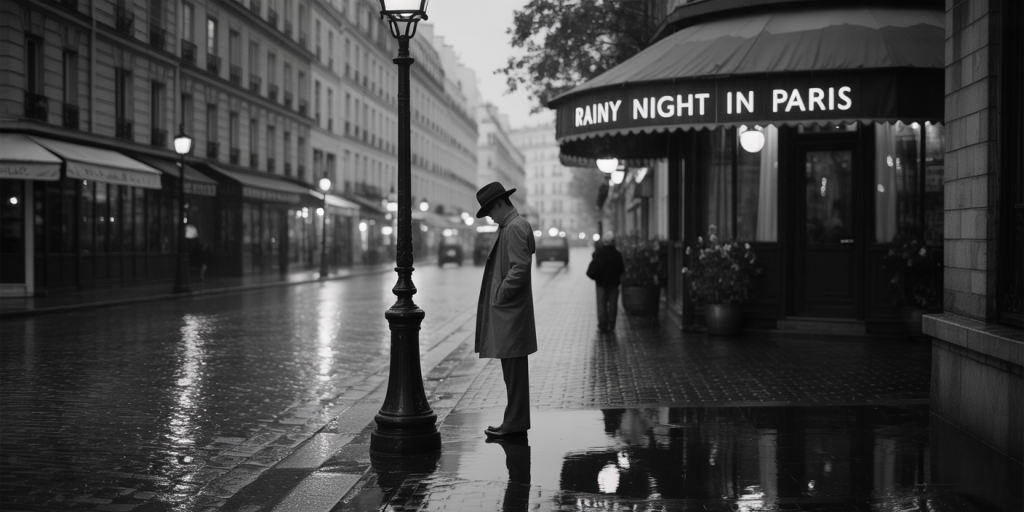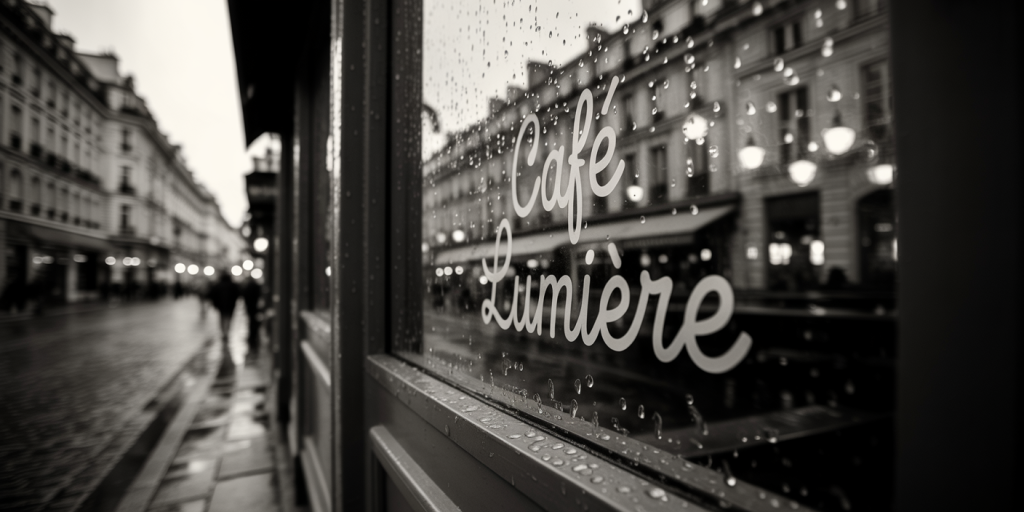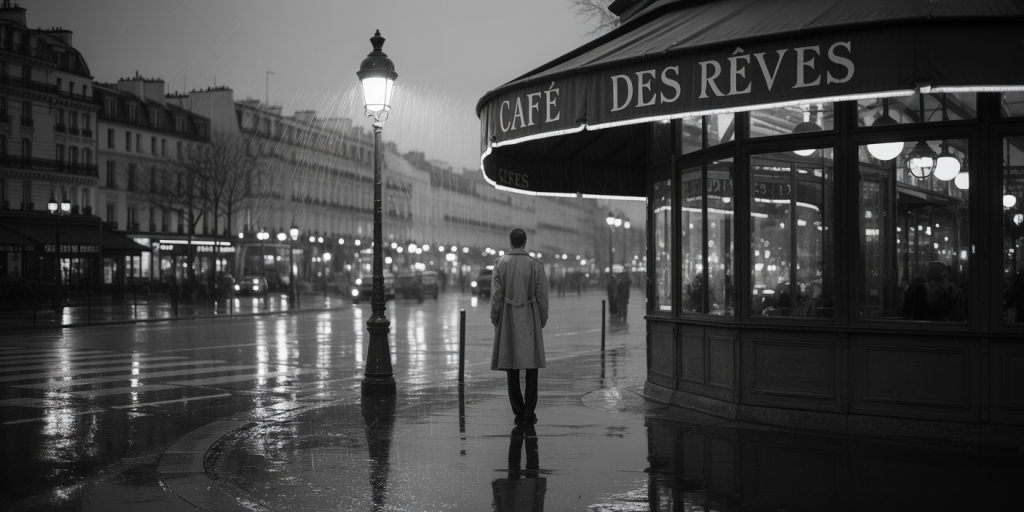Rain Over Paris and the Intimate Lens of Brassaï
Rain falls differently in Paris. It doesn’t rush or lash—it lingers, it listens. In Brassaï’s vision, Paris in the rain is not a weathered cliché but a whispered confession. His camera doesn’t simply record the city; it cradles it. Under his gaze, every raindrop is memory, every puddle a pool of reflection—literal and emotional. Paris becomes a diary written in cobblestones and fog.
Brassaï’s nocturnal Paris is not the Paris of postcards. It is the Paris of secrets and solitude, of lovers folding into alleyways, of wet lamp posts holding onto light like tired arms. He does not chase grandeur. He waits for it to exhale—softly, subtly, through rain-slicked bricks and the curve of a forgotten staircase. This is a city blurred by affection, focused through longing.

Poetic Table of Contents
- Cobblestones That Remember Footsteps
- Puddles as Silent Diaries
- The Glow of Lamp Posts Like Memory
- Wet Windows and Inner Lives
- Reflections that Refuse to Disappear
- Alleyways as Whispered Verses
- The Texture of Rain on Film
- Faces Found in Shadows
- The City as a Mirror of Solitude
- Stillness Between Drizzles
- Love Paused in a Misty Glance
- Framed by Fog, Fractured by Feeling
- Stairwells Holding Echoes
- Light Rain on Heavy Doors
- Cafés Behind Glass Veils
- Umbrellas as Portraits of Distance
- Streets Folding into Dream
- Rain as Emotional Architecture
- Paris Through the Eyes of Silence
- Moments Suspended in Moisture
Cobblestones That Remember Footsteps
Brassaï’s streets are not paths—they are palimpsests. The rain wakes up the stones. With each slick gleam, they recall every foot that has pressed them, every late-night whisper that passed their edge.
His framing makes the ground as important as the sky. These cobblestones glisten with intimacy. They are not surface—they are soul.
Puddles as Silent Diaries
Each puddle in Brassaï’s Paris is more than water. It is a page, a page written in light and distortion. The reflections hold secrets. Lovers’ glances, hurried steps, a cat’s tail disappearing.
He doesn’t just photograph puddles. He listens to them. They do not show—they confess.
The Glow of Lamp Posts Like Memory
Streetlamps in Brassaï’s work are melancholic sentinels. Their glow is not sharp—it bleeds. It hesitates. It hangs in the rain like breath.
This light doesn’t command—it caresses. It warms the viewer with nostalgia, even in the cold. It feels remembered, not observed.
Wet Windows and Inner Lives
Brassaï’s lens often peers through glass—rain-soaked, fog-blurred, dream-heavy. These windows do not offer views; they suggest veils. Behind them, lives unfold slowly, quietly.
The droplets on the pane are punctuation marks. Pauses. Hesitations. Each one a moment suspended between the inside and out.
Reflections that Refuse to Disappear
Reflection, for Brassaï, is not a trick of optics—it is a metaphor. Wet surfaces double the world. The rain does not obscure; it reveals two versions of truth.
Figures appear twice, once in reality, once in myth. Paris becomes both real and remembered, solid and fluid.
Alleyways as Whispered Verses
Brassaï’s alleys are not empty—they are awaiting. They are verses not yet read aloud. The curvature of a stone wall, the soft spill of light around a corner—they all hum with potential.
He gives silence texture. The narrowness is not confining—it is intimate.
The Texture of Rain on Film
Film grain becomes rain’s accomplice. Every droplet softens the image. It makes edges tremble. It lends the city its tactile sorrow.
Brassaï did not chase sharpness. He embraced the fuzz of feeling, the warmth of emotional weather. The rain becomes part of the photograph’s skin.

Faces Found in Shadows
His portraits are not well-lit declarations. They emerge from shadow. The face is not always clear, but the presence is.
Brassaï lets the darkness participate. He respects it. In doing so, the figures feel truer—not because we see them fully, but because we feel their nearness.
The City as a Mirror of Solitude
Brassaï’s Paris is never crowded. Even when people appear, they are alone—even together. The city mirrors this solitude. It stretches, gently, to cradle each isolated soul.
Solitude here is not sadness—it is introspection. It is the gentle turning inward that rain brings to all of us.
Stillness Between Drizzles
Rain comes and goes, but Brassaï captures the in-between. That quiet when the last drop hits, and the city breathes in its new damp self.
These are the moments where silence pools. Where emotion settles like mist between bricks. He listens, and we do too.
Love Paused in a Misty Glance
Couples in his work do not embrace for the camera. They simply exist. Their love is paused, not posed.
The rain, again, helps. It slows the moment. It softens urgency. What remains is not a kiss, but a nearness. Not declaration, but presence.
Framed by Fog, Fractured by Feeling
Fog becomes Brassaï’s frame. It edits the city gently. Removes clutter. Hides the irrelevant. What’s left is emotion in architecture.
Fog, like love, like grief, makes the world both clearer and harder to read. Brassaï lets that contradiction remain unresolved—and resonant.
Stairwells Holding Echoes
Interior shots often include staircases—spiraling, old, shiny with wetness. They carry more than bodies; they hold echoes.
Every step feels metaphorical. An ascent into memory. A descent into self. The stairwell is more than passage—it is poetry in steps.
Light Rain on Heavy Doors
The city’s thresholds glisten. Heavy doors that once intimidated now welcome through dampness. Rain makes every surface softer, including barriers.
Brassaï captures that change. The impenetrable becomes porous. The city exhales. Its defenses wet with empathy.
Cafés Behind Glass Veils
Cafés become sanctuaries. Seen from outside, they are warm blurs. People inside laugh, argue, sit silently. But the glass blurs them all equally.
This blurring is not distance—it is dreaming. The city watches itself through Brassaï’s lens, and sighs with recognition.
Umbrellas as Portraits of Distance
Umbrellas abound. They are not protection—they are punctuation. They mark the space between people. They are poetic devices.
Under one umbrella: intimacy. Two umbrellas: parallel monologues. The rain measures distance as much as it measures wetness.
Streets Folding into Dream
Sometimes, his streets curve like lines in a lullaby. The rain exaggerates the softness. Curbs melt. Corners yawn. The city folds into itself like tired linen.
In those folds, dreams sleep. And Brassaï, ever gentle, photographs them before they wake.
Rain as Emotional Architecture
The architecture in Brassaï’s work is never dry. Rain adds meaning. It curves arches, deepens doorways, rounds out façades.
It does not erode—it caresses. The buildings respond. Stone blushes. Metal sings. Paris becomes not just background, but protagonist.

Paris Through the Eyes of Silence
His city does not shout. It barely speaks. But it sees. And it invites us to see as well—not with judgment, but with gentleness.
Brassaï’s silence is not empty—it is full of listening. Full of feeling too tender for words. In his lens, Paris becomes a love letter with no need for reply.
Moments Suspended in Moisture
Each photo feels like it might dissolve at the edges. Like it was caught just before vanishing. Rain holds the moment like fingers cradling a flame.
These are not just images—they are breaths. Damp, fleeting, necessary. And when we exhale, we do so slower.
FAQ – Questions and Answers
Who was Brassaï?
Brassaï was a Hungarian-French photographer best known for capturing the essence of Paris at night. His work in the 1930s brought light to the city’s undercurrents—its solitude, mystery, and tenderness.
What was unique about his approach to night photography?
He embraced low light, grain, and reflection. His night scenes weren’t about technical perfection but emotional truth. He used long exposures and natural light to capture Paris as it whispered to itself.
How did rain influence his compositions?
Rain softened the city, added texture, and created reflective surfaces. It turned ordinary streets into mirrors and added emotion to surfaces. Brassaï used rain as both subject and mood.
Was Brassaï’s Paris romanticized?
No. It was humanized. He didn’t romanticize poverty or strangeness—he dignified it. His Paris was not glossy, but deeply felt.
Why does his work still resonate today?
Because it sees. And in seeing, it reminds us to look again—not just at others, but at our own emotional landscapes. His photographs feel like whispered truths.
Final Reflections – Paris in a Pool of Light
Brassaï did not photograph the rain. He listened to it. He walked with it. He let it show him a Paris too shy for sunlight, too delicate for daylight’s declarations. Through his lens, we are offered not a city, but a sentiment—a sensation suspended in shadow and sheen.
In the puddles, we see ourselves. In the fog, we find softness. And in the quiet frame of his night-time Paris, we rediscover how to look—not to capture, but to cherish. Each droplet in Brassaï’s work is not just water. It is time. It is tenderness. And it still falls.
